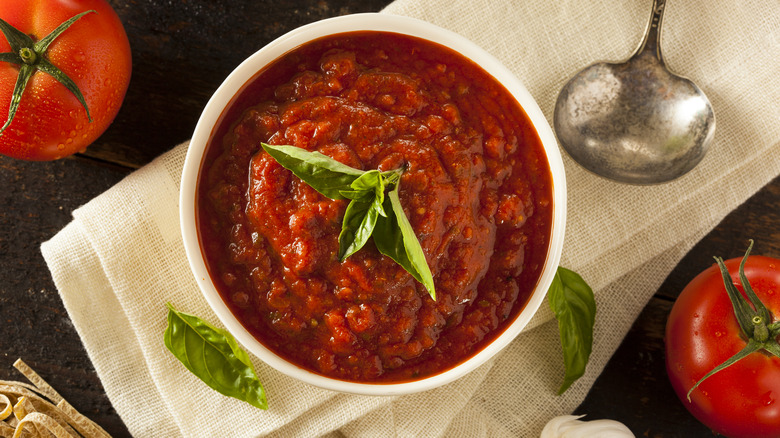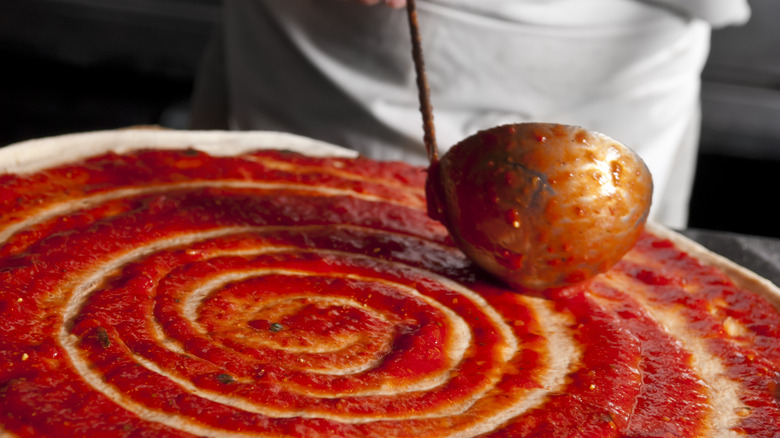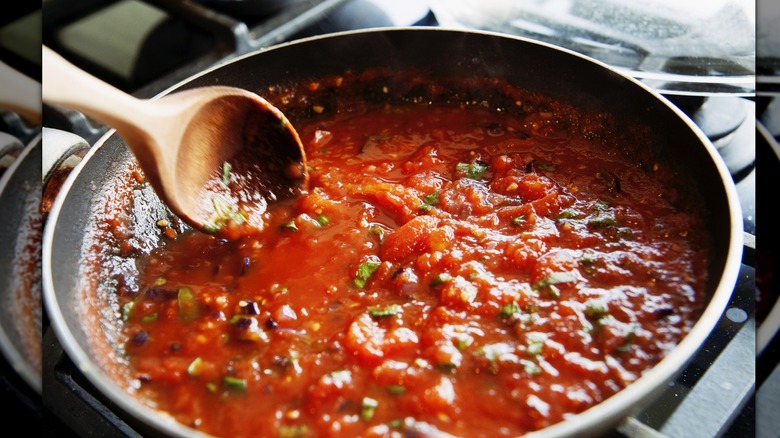Pasta Sauce Vs Pizza Sauce: Is There Any Difference?
In Italian cuisine, you're sure to notice a recurrence of certain ingredients — rich, cornerstone Mediterranean staples like olive oil, garlic, balsamic vinegar, and, of course, tomatoes. It's all of these components that make Italian food so universally adored; according to The Picky Eater food blog, there have been roughly 20 trillion Instagram hashtags tied to Italian food through 2023. Though these ingredients reappear in many signature Italian dishes, there are subtle distinctions in how they're prepared and combined that gives each its own unique flair.
Pasta sauce and pizza sauce are the perfect example of how these subtle differences matter. Despite sharing tomatoes as their base ingredient, there are a few key differences between a standard pasta sauce and pizza sauce. Namely, pasta sauce comes is cooked during its preparation while pizza sauce does not, and pasta sauce typically comes with more ingredients than pizza sauce.
Why cook one and not the other?
The reason that jarred pasta sauce comes pre-simmered and pizza sauce comes raw corresponds to how each dish is prepared. When making pasta, you would typically cook the noodles separately and mix them into the sauce afterwards. Since the pasta sauce does not necessarily get the extra cooking treatment, the precooking process guarantees the smooth and robust flavor that the raw ingredients cannot deliver. During the simmering process, it is common to add in flavorful ingredients like basil, parmesan, onions, and even ground meat to further enhance the sauce's flavor and the pasta dish as a whole.
When making pizza, on the other hand, the sauce gets cooked with the crust. If it were pre-simmered like pasta sauce, it would run the risk of overcooking and losing its fresh, vibrant tomato flavor. Letting the sauce cook along with the rest of the pizza helps ensure that it hits its flavor sweet spot. The recipes for pizza sauce also tend to be more stripped down than pasta sauce. There may be some oregano and olive oil, but keeping the sauce simple allows the pizza's toppings to shine.
The secrets to the best sauces
Buying your pasta and pizza sauces pre-made is a great timesaver, and as delicious as they can be, there are many easy ways to make them even tastier. For instance, celebrity chef Giada DeLaurentiis recommends adding parmesan rinds to store-bought sauces to elevate their flavor and avoid waste. Or, if you want to amp up the umami of your tomato sauce, consider mixing in some fish sauce.
Alternatively, you can make your own sauce totally from scratch. If you choose the homemade route, the San Marzano tomato is the best type you can use. It's a paste tomato, meaning it's meaty and has a thick skin, thus perfect for a rich puree to lay over pasta or dough. Heirloom tomatoes have a similar build, and work for sauces as well. A good tomato sauce can tie the flavors together in either dish, just don't skimp on the ingredients when the recipe is this basic.


